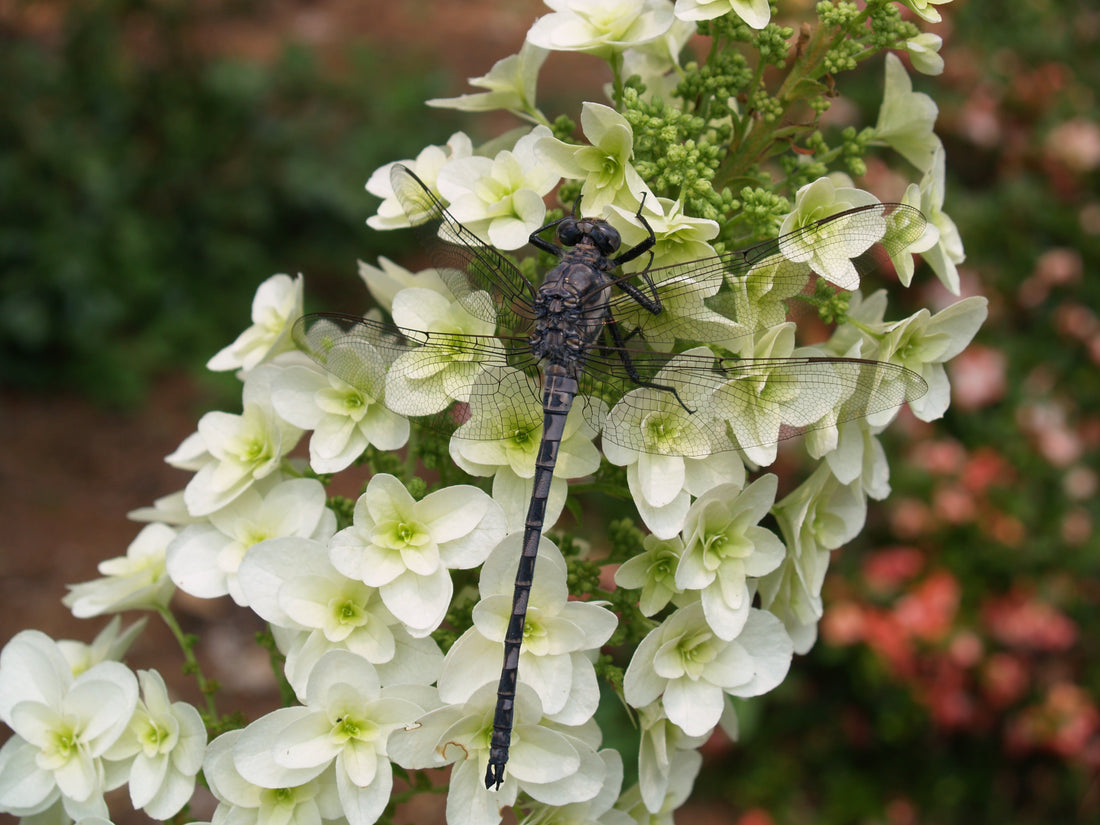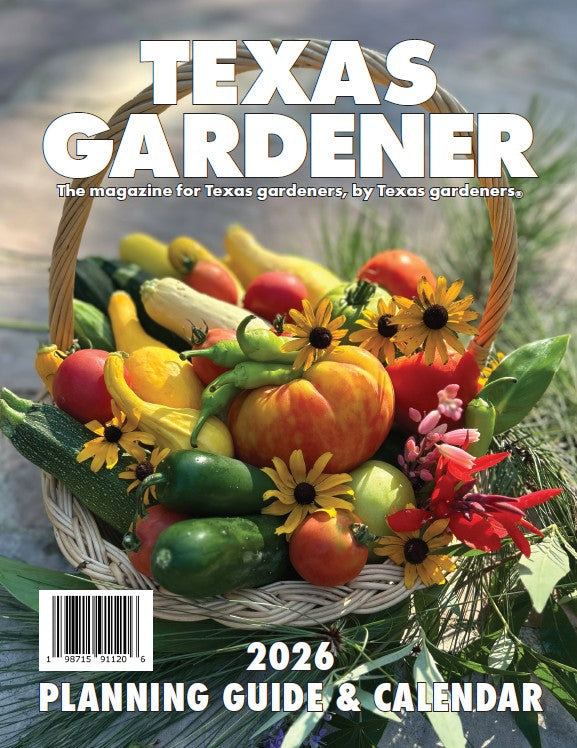
BIG, BOLD, BEAUTIFUL OAKLEAF HYDRANGEAS
Share
By Keith Hansen
Smith County Horticulturist, Emeritus
Texas A&M AgriLife Extension Service
Owner, East Texas Gardening
A
s the blooms of springtime-flowering shrubs fade, it is nice to have other plants fill the gap with color. Hydrangeas, for example, flaunt large trusses of showy flowers at that time. The word “hydrangea” comes from Greek, meaning “water vessel.” The word dates to the 1700s, when an English botanist named Philip Miller received some plants from the American botanist John Bartram, who thought their seed capsules looked like little vessels for holding water. I always thought the name was due to the large leaves and that the plants needed to be planted on sites with moist soil. While that may be true, now I and you know the backstory of the name of this wonderful genus.
There are about 70 different species of hydrangeas native to North America and Asia, but only a small handful that we grow in our gardens. These different species of hydrangeas each have their own unique flowers and growth characteristics, and (where adapted) can bring star flower-power to your garden. I’d like to highlight a native American variety that is one of my favorites.
Oakleaf hydrangea (Hydrangea quercifolia) is an outstanding shrub for Texans who live in the eastern part of the State. It is native to the southeastern United States, including eastern Louisiana, Mississippi, Alabama, Georgia and northern Florida. You may have seen it blooming along the interstate highway as you travel eastward through these states. This deciduous, medium-sized shrub has several characteristics that make it a winner. First, it prefers a partly shaded site, which is usually not too hard to find in urban landscapes. Ideal light locations for planting would be morning sun or under a high tree canopy, where it would receive very bright light throughout the day. It will grow in sunnier spots with well-mulched, evenly moist soil, but preferably avoid direct sunlight from late morning through sunset.
In May and June, oakleaf hydrangeas bear large, attractive, showy, conical inflorescences of creamy-white flowers. There are many named cultivars, but all provide stunning white flowers held above and set off by large three-to-five-lobed, oak-shaped leaves, which is how they got their common and scientific names. Quercifolia means foliage similar to oak leaves. Depending on variety, the leaves of this hydrangea range from three-to-eight inches long. Flower clusters might be four-to-12 inches long and three-to-four inches wide. Interestingly, the showy white floral color comes from sepals, petal-looking modified leaves that subtend and protect the fertile flowers. The white sepals transition to a pinkish color, and then persist as a brown paper-like cone into fall and winter.
Continuing the show in fall, the large, oak-shaped leaves, which are an attractive deep green all summer, turn reddish-purple or burgundy before dropping in the winter after a hard freeze. Leaf colors will be more pronounced for plants receiving more sunlight and will vary with cultivar. Once the leaves are gone, exposed branches show off their exfoliating paper-like bark. The bark begins peeling on three-year-old stems to reveal a rich, dark-brown inner bark.
Oakleaf hydrangeas are readily useful wherever a bold texture is needed. Smaller cultivars, like ‘Little Honey’ or ‘Sike’s Dwarf’, can be grown in a small bed as an accent plant. I like to use oakleaf hydrangeas mixed with other plants to create an informal, living border where their bold form and white display can be appreciated. Their white sepals really show off in front of taller evergreens or fences. Larger varieties are very effective when sited on the edge of a wooded lot.
Oakleaf hydrangeas do best with an acidic-to-neutral soil pH. Like most of the large-leafed hydrangeas, newly planted specimens will tend to wilt during hot summer days in the first year. If they wilt early in the morning, that might indicate that the soil is too dry and needs watering.
Oakleaf hydrangeas have very few pests, tolerate a wide range of soil and moisture conditions, are long-lived and readily available. Just give them room to grow. While many references state they grow four-to-six feet tall, they can possibly get twice that size with age, depending on variety and in what part of the state you live. There are a few smaller, more compact cultivars that will not swallow up a whole bed. They can sucker (not too extensively), so a planting can easily grow to the same width as its height.
Flower buds are formed on previous year’s growth, so only prune them, if needed, after flowering. I usually leave the spent blooms attached well into the winter to provide additional architectural interest and contrast. But eventually they start drooping and are easily snapped off once they no longer enhance the plant’s overall appearance.
Here are a few of the more popular cultivars you should be able to find in nurseries or online.
‘Ruby Slippers’, a hybrid between ‘Snow Queen’ and ‘Pee Wee’ (a small, compact cultivar), was introduced in 2010 by the National Arboretum. I have grown it for many years. It maintains a tight, compact form, and mine is now about five feet tall and wide. The mostly sterile white flowers fade to pink, but do not turn ruby red, like they might in cooler climates. The fall foliage color is an awesome burgundy and red. Its overall smaller growth habit makes it ideal for landscaping use in smaller residential lots.
‘Little Honey’ is a branch sport of ‘Pee Wee’. Its leaves start out almost yellow in the spring, transitioning to chartreuse and then green in the summer. Its smaller height and blooms, plus the brighter spring foliage, make it a good candidate for small beds that do not get bright sun in the afternoon.
‘Sike’s Dwarf’ is, as the name implies, a compact oakleaf hydrangea ideal for smaller spaces. It grows with a rounded form, heavy flowering and good fall color.
‘Munchkin’ is a seedling of ‘Sike’s Dwarf’. It is more compact than its parent and was introduced by the breeding program at the National Arboretum.
‘Snowflake’ is a large cultivar with long inflorescences. Its multiple white sepals result in even more flower power.
‘Snow Queen’ grows to a medium-sized shrub, perhaps six-by-six feet, with large, eight-inch-long cones of white blooms held erect above the foliage. The blooms reliably turn pink as they age. This will be the next variety I will add to my landscape along a creek, where it will get morning sun and afternoon shade with a backdrop of evergreen cherry laurels and river birch.
There are many more cultivars you might find by doing a search for an online store. I saw a new series I am unfamiliar with called the Gatsby series, which looks interesting. In general, I do not think you can go wrong with any variety if you have the right conditions to grow it.
In one area of my landscape, I have an unnamed seedling plant that blooms at the same time as an East Texas native, white-blooming Texas azalea (Rhododendron oblongifolium) and the late-blooming pink ‘Wakaebisu’ azalea. The combination of these plants makes a pleasing and interesting contrast in color and form. If the pH of your soil is not much over 7.0, then give oakleaf hydrangeas a try. Oakleaf hydrangea is a wonderful late-spring landscape attraction that, in fact, provides year-round interest with its large leaves, attractive white blooms, colorful fall foliage and interesting bark and growth habits. tg

